How to Choose the Best Media Marketing Solution
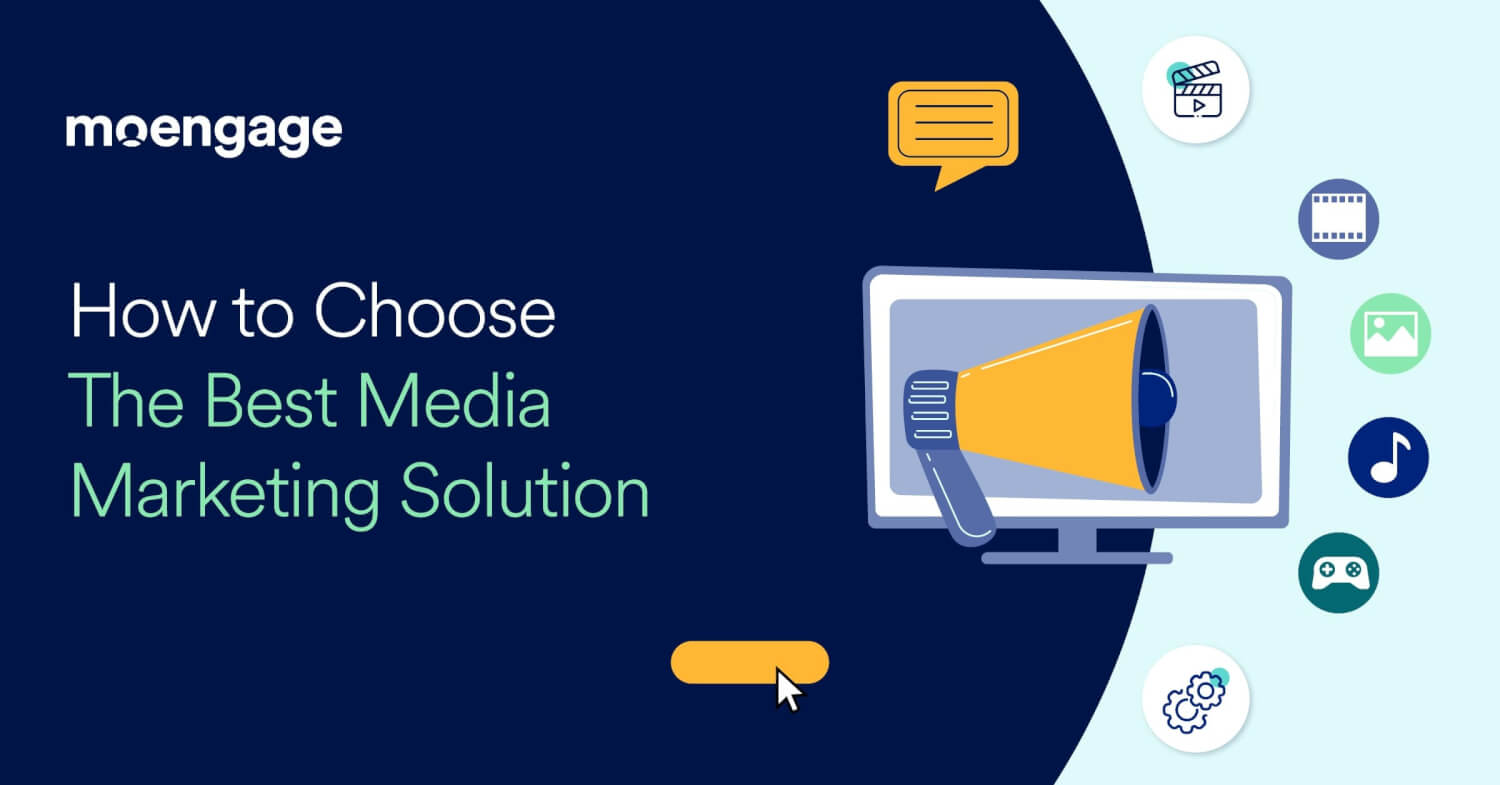
Reading Time: 14 minutes
In our recent survey on cross-channel marketing, 34.7% of media and entertainment brands indicated that they used only basic demographic data – such as name, age, gender, and geographical location – to personalize their marketing efforts.
As many media platforms are built on subscription-based models, this level of personalization often isn’t enough for you to retain customers as loyal paid subscribers.
It’s too easy for consumers to jump from one platform to another with the amount of choices available. Thus, you need an omnichannel solution that takes actual customer behavior and preferences into account.
This kind of hyper-personalization must be the cornerstone of your media marketing strategy. Also, having a media marketing tool that supercharges your efforts to increase customer engagement and loyalty is critical to that strategy’s success. These are some of the key ways that successful media platforms like SoundCloud and Netflix have used to maintain such large customer bases.
In this blog, we cover the intricacies of media marketing software, its benefits, key features, how to choose the right one, and more.
What is Media Marketing Software?
Media marketing software enables the marketing and engagement efforts of media-based websites and apps (such as streaming services). It offers automated customer engagement capabilities that can increase users, convert more users to subscribers, and increase in-app content consumption.
Using media marketing software leads to less wasted resources, efforts, and spending on marketing campaigns that don’t work. It does so by helping you hyper-personalize your customer engagement efforts to increase campaign effectiveness and enable retention.
9 Benefits of Using a Media Marketing Platform
A media marketing solution helps you keep your viewers, listeners, and readers engaged and satisfied with your content and app/website. This leads to your platform gaining increased adoption, subscriptions, and loyalty – which, in turn, improves the average order value (AOV), customer lifetime value (LTV), and overall revenue.
Specifically, media marketing solutions enable you to:
- Acquire and nurture customers based on their intent: Identify customers with the highest propensity to subscribe, and provide a curated experience that guides them to convert and become subscribers.
- Reduce paywall and subscription friction: Streamline conversion funnels by offering consistent communication and onboarding support, limiting friction and making it easier for your viewers, listeners, or readers to subscribe.
- Reduce churn and abandonment: With more control over your engagement strategy and campaigns, you can better understand what causes customers to leave your platform and crack down in a meaningful way that prevents churn and improves retention.
- Recover abandoned customers: Reactivate customers who have unsubscribed using targeted recapture campaigns that understand what customers want.
- Deliver content that resonates with customers: Create, package, and deliver content, recommendations, and experiences that your audience doesn’t just interact with – they truly connect with it.
- Create immersive experiences: Craft interactive, enticing experiences that gain traction with your audience, increasing engagement and brand loyalty.
- Create complex campaigns without code: Build highly personalized, targeted campaigns easily and effortlessly without code, reducing your go-to-market time.
- Save time, resources, and money: Automate workflows and campaign optimization, allowing you to invest your resources in more strategic areas.
- Expand and grow: Focus your efforts on growing your customer base, expanding product offerings, and driving subscriber loyalty using hyper-personalization.
It is evident that certain aspects of successful marketing for a media app cannot be achieved without the use of media marketing software. However, it is crucial to keep in mind that generic marketing platforms often lack the necessary features that are specifically useful for media platforms.
So, how do you select a marketing software that will truly be effective for your media app or website?
Media Marketing Solutions Evaluation Criteria: How to Choose One
Our research found that 46.3% of media & entertainment organizations admitted to not knowing which of their customer cohorts were not converting, compared to an industry average of 33.5%.
Effective marketing that drives engagement and builds brand loyalty requires a customer engagement platform that can understand customer behavior to determine what is and isn’t working, and then appeal better to individual customers. This means that an ideal media marketing software must have certain features that media brands require to build and run effective campaigns – which generic marketing platforms won’t have.
Here are the key functionalities a media marketing platform should have, in order to help you acquire, engage, retain, and grow your customer base:
1. Insights and analytics
Accurate and reliable data plays a crucial role in effective marketing. According to insights from our State of Cross-Channel Marketing report, 34.74% of media and entertainment marketers say that leveraging customer data analytics for targeted marketing decisions is most important for building an effective cross-channel campaign. However, when data is incomplete, inconsistent, or inaccurate, it can lead to errors in your analysis and decision-making.
Having meaningful and actionable insights enables you to develop highly personalized customer engagement strategies and campaigns that are more likely to resonate with your customers. You can provide customers with a better experience of your service by understanding their preferences and past behavior. This, in turn, improves customer satisfaction, reduces churn, increases engagement, fosters loyalty, and ultimately boosts conversions and revenue.
| Why This Is a Key Criterion: Eliminate the guesswork from your customer engagement efforts by rooting your marketing strategy and campaign in deep customer data. |
2. Customer segmentation and cohort analysis
Customer segmentation is the foundation of any personalization strategy. Without accurately segmenting your customers, it will be challenging to dig deeper and provide hyper-personalized experiences that resonate with customers.
One way to distill customer insights is through cohort analysis. This is a time-bound strategy that allows you to pinpoint your brand’s good and bad months based on revenue generated, new subscriptions, and churned customers. Use cohort analysis to identify your platform’s features that drive the most engagement, and find the root causes of obstacles across your customers’ journeys.
On the other hand, customer segmentation is an ongoing process of dividing your customer base into different groups based on shared characteristics or behavior. It allows you to understand which customers are the largest contributors to revenue and have the highest growth potential.
It’s possible to segment your media platform’s customers by personal preferences and viewing or listening behavior, and these segments should inform your marketing efforts. You must use customer segmentation when you want to deliver a better customer experience, increase LTV, and identify friction points.
By analyzing cohorts and segmenting customers, you can track your platform’s feature usage, identify friction points, and pinpoint groups of customers most likely to churn. All of this allows you to develop highly focused engagement campaigns that enable you to offer personalized marketing to your viewers, listeners, and subscribers.
| Why This Is a Key Criterion: Customer segmentation and cohort analysis allow you to dive deeply into what customers care about — and then deliver it; enabling you to power hyper-personalized customer experiences. |
3. Omnichannel marketing
Customers want to consume media when and where it is most enjoyable and convenient for them. That’s true whether they’re viewing sports coverage, a TV show, or a film; watching/reading the news, or listening to a podcast.
Omnichannel marketing is all about creating a seamless, cohesive experience for customers engaging with your content and brand—regardless of the channel they use.
You can use an omnichannel approach to identify the best channels for their messages, and provide contextually relevant content recommendations that follow a consistent messaging — across channels. This allows you to offer customers unique, personalized experiences based on how they prefer to engage with your content.
| Why This Is a Key Criterion: An omnichannel approach provides customers with a familiar, recognizable experience across all touchpoints and channels and creates numerous cross-selling opportunities. |
4. Customer journey orchestration
An ideal media marketing solution will offer marketers customer journey orchestration capabilities to create curated, frictionless experiences that improve the user interface and experience. For media and entertainment companies, this involves creating seamless pathways that enable customers to navigate the platform with ease.
It is also essential to build customized journeys based on specific stages within the platform. This includes personalizing customer experiences based on factors such as whether they are new users, utilizing the free version, using a discounted or promotional rate for a premium subscription, or having been subscribed for several years.
By tailoring the experience to each customer or segment, companies can enhance customer satisfaction and engagement.
| Why This Is a Key Criterion: This feature allows marketers to create curated customer journeys without code that guides customers down the optimal pathway, increasing engagement at the optimal time, using the best channel, and with the right content. |
5. Hyper-personalized content and experiences
Modern audiences expect highly personalized experiences, especially from their media platforms. To keep customers engaged and interested, you need to craft experiences they want to stay around for, serving them what they want to consume. This means considering factors such as which channels they most interact with, what times they typically access your service, where in the world they are, and which language(s) they prefer for content and interfaces.
Viewers, readers, and listeners need relevant content recommendations that keep them engaged, or they’ll look for another service that can deliver the experience they want.
Hyper-personalized content and experiences allow you to connect with customers on a one-to-one basis, curating experiences that truly resonate with them. All of this translates into more time spent using your service, increasing subscriptions and revenue.
| Why This Is a Key Criterion: You can build highly targeted, personalized marketing campaigns, experiences, and content recommendations that drive engagement and increase AOV, LTV, and revenue. |
6. AI-powered campaign optimization
Creating and optimizing personalized marketing campaigns for your customers manually and at scale is virtually impossible. This is especially true in media and entertainment, where services tend to have hundreds, thousands, or even millions of customers using them at the same time. That’s why you need something like artificial intelligence (AI) to do the heavy lifting for you.
AI-powered campaign optimization enables you to automate the bulk of your optimization efforts. These include tasks like predicting high-level customer behaviors (such as likelihood to churn), the channels customers most often use to engage with your platform, the times at which customers typically use your services, and – based on all of this – the optimal journey for each customer.
AI can do all of this in real time, without needing you to intervene. This allows you to move from reactive to predictive customer engagement, so you can craft better customer journeys and experiences At the same time, it frees up time, resources, and money that you can invest in other areas that contribute directly to your business’s growth.
Many media platforms use AI to inform content recommendations, but don’t realize they could also be using it to optimize their omnichannel marketing as well. For example, Generative AI can let you quickly put together campaigns that use relevant keywords, tones of voice, or writing styles. This can make it easier to reach specific audiences and nudge them towards certain behaviors (e.g. appealing to price-sensitive customers’ sense of FOMO to get them to take advantage of a sale or another limited-time offer).
| Why This Is a Key Criterion: AI helps to predict customer behavior, optimize your omnichannel campaigns in real-time, and generate use case-specific copies that have a higher likelihood of engaging your customers. |
7. Marketing automation
As your audience grows, it gets more challenging to effectively execute your marketing strategy. The more channels you use and customer segments you identify, the more complicated the entire process becomes, which can create a hefty workload for your marketing team.
Marketing automation allows you to automate a variety of marketing processes, from entire workflows to individual campaigns. This empowers you to scale your marketing efforts, whether you are a startup or an enterprise-level media company.
| Why This Is a Key Criterion: Marketing automation empowers media marketers to deploy campaigns seamlessly, as well as optimize those campaigns using real-time triggers that fire based on customer activity. |
Best Media Marketing Solutions: Key Features
Ensuring your media marketing solution meets your specific needs is the best way to choose a specific tool. MoEngage is a tool that works very well for media and entertainment brands, and can meet the needs of any growing media platform.
Here’s how:
| Media Marketing Software Needs | MoEngage Feature | Examples of How This Helps |
| Analytics and Insights | MoEngage’s Open Analytics tool offers clear direction in what’s working well, and what needs to be iterated for future campaigns. | Understand whether a marketing campaign for subscription renewal is resonating with customers and leading to conversions. |
| Customer Segmentation | MoEngage’s segmentation capabilities allow you to dig deeper than traditional customer segmentation, factoring in behavioral and other cues. | A customer who’s price-sensitive and always looking for good deals could be sent messaging focused on limited-time discount offers. |
| Omnichannel Marketing | MoEngage’s omnichannel capabilities allow brands to begin their customer engagement journey on whatever channel resonates best with their customers, and cohesively expand their strategies as they grow.
|
Analyze which channels are performing best and learn about how your customers interact with your engagement efforts to streamline your messaging and optimize content recommendations.
Move seamlessly from email to push notifications if you see your consumers engaging with you on their mobile devices, and cohesively continue the conversation as if they never switched screens. |
| Customer Journey Orchestration | MoEngage’s customer journey builder, Flows, enables marketers to craft and automate seamless campaigns that are familiar and recognizable across all channels. | Build different customer journeys for free users vs. new subscribers vs. long-term subscribers. Entice users to upgrade from a free trial to a paid subscription with incentivized messaging that resonates with each consumer. |
| Hyper-personalized Experiences | MoEngage’s personalization capabilities (such as website personalization) allow you to reach customers on their favorite channels, at their preferred time, in their preferred language, and with content of their choice. | A customer has listened to an artist every day for the past week, so a mobile push notification is sent with a reminder to stay tuned for the artist’s upcoming album, increasing the likelihood the customer will listen to it when it’s released. |
| AI-powered Campaign Optimization | MoEngage’s Sherpa AI can predict customer behavior and optimize campaigns in real-time, increasing the efficiency of the overall marketing campaign.
In addition, MoEngage’s Merlin AI can quickly generate campaign messaging designed to appeal to specific audiences and elicit certain actions. |
Using Sherpa AI, media marketers can predict customers who are about to churn and re-engage them with personalized offers and content recommendations. |
| Marketing Automation | MoEngage’s Smart Triggers can send an automated follow-up based on customer behavior, and can automatically implement personalized campaigns at scale. | A user reviews the pricing plans page for subscriptions within the app and then receives an email offering a discount on a premium subscription the following day. |
6 Key Metrics to Evaluate the Success of Your Media Marketing Strategy
Once you implement a media marketing strategy, it’s critical to evaluate its success by tracking key metrics specific to the media industry. Based on this you must continuously iterate and optimize your your strategy.
Re-engaging and retaining customers is a critical focus for any media platform, so here are a few key metrics to track to ensure your media marketing strategy is a success:
1. Content consumption
What’s the basis of any media platform? Content. So what’s one of the best ways to measure the success of your media marketing strategy? Content consumption.
Tracking how much content each customer consumes (and at what pace) is critical to determining how successful your marketing efforts have been. So too is measuring how much time a customer spends in-app, and how your marketing about specific content is impacting their usage of the app.
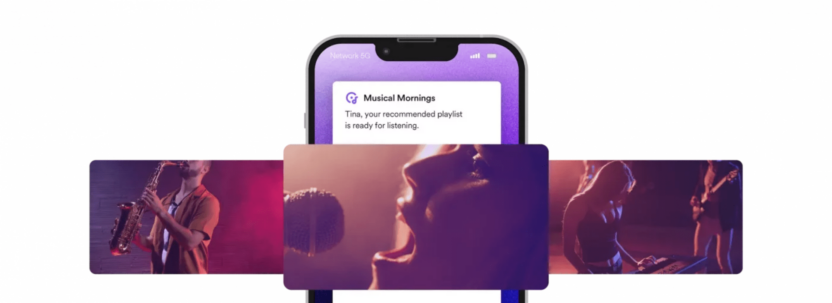
After you send an in-app message or push notification to a customer to discover a new artist or listen to a new song you think they’ll love, how often are they consuming that content, and then consuming further content by that artist? Are you sending too many notifications or not making enough suggestions?
Tracking content consumption after marketing campaigns are in place is critical to understanding the impact your media marketing tool and strategy are having on customer behavior.
2. Number of active users (DAUs, WAUs, & MAUs)
A few standard metrics are important to any app-based service. Tracking Daily Active Users (DAUs), Weekly Active Users (WAUs), and Monthly Active Users (MAUs) is very important to media-based apps. This is because the subscription-based model is often only enticing to users who plan on using the app regularly and on a long-term basis.
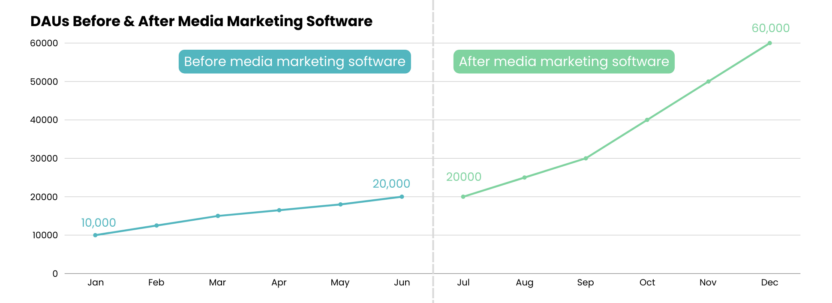
Establish the active user numbers you’ve had in the period of time prior to implementing your media marketing software and engagement strategy, and then track the increase in active users afterwards. This will give you a baseline of how your media platform was performing prior to using your new tools and strategy, which will directly show you how impactful these things have been in increasing your active user numbers.
3. Improvement in upselling
Tracking the impact of marketing campaigns related to converting regular users on a free plan into subscribers will help determine how successful your marketing strategy is. Think of Disney+’s campaign to offer a discounted price of $1.99 per month for 3 months (instead of the usual cost of $7.99/month) for those who signed up prior to the addition of Taylor Swift’s The Eras Tour (Taylor’s Version) concert film.
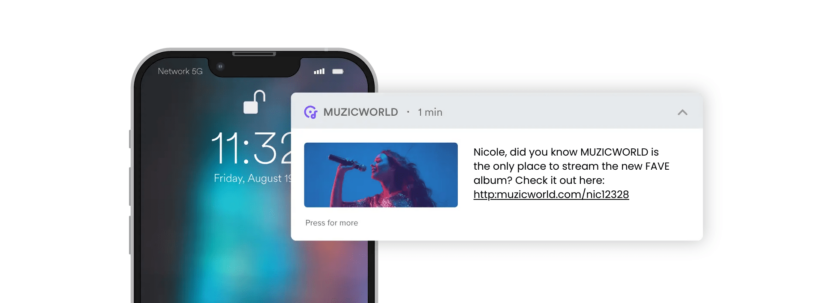
Offering a discounted first month or few months, or running campaigns related to specific artists or platform-exclusive content, are great strategies for increasing paid subscriptions. Tracking the increase in subscribers through the marketing platform is a great way to determine the success of the campaigns.
| Learn how Audiomack was able to use MoEngage’s customer journey orchestration capabilities to personalize customer communications, increasing the conversion rate of free trial users to paid subscribers by 18%. |
4. Number of reactivated users
Because of the typical subscription-based model of many media apps, some users cancel their subscriptions after an initial promotional period ends – often because they consider the cost of the full subscription to be too high. Tracking how many users come back as subscribers based on media campaign outreach is an important component of media marketing strategy success.
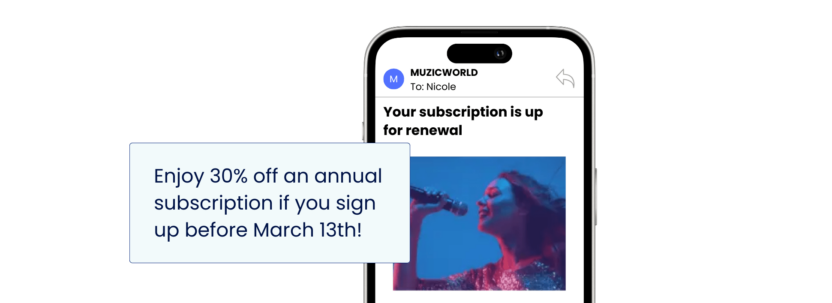
This can often be achieved through push notification campaigns or in-app messages if the user is still using the free version of the app.
Tracking how effective these campaigns are with custom links in a media marketing platform is one of the most effective ways to determine how well your app is bringing paid users back into the fold.
| Read how Publishers Clearing House used MoEngage’s predictive AI and dynamic A/B campaign testing to reactivate over 30,000 dormant users. |
5. Subscription renewals
Turning a media app user into a paid subscriber is one of the biggest hurdles for media and entertainment brands. But retaining these paid subscribers can be even tougher. Often, subscribers will ride out their subscription period and then reconsider their options.
For example, if your app offers year-long subscriptions rather than monthly ones, users will often end their subscription at the end of the year. This is especially the case if they previously received a discount they are no longer going to receive when their subscription renews.
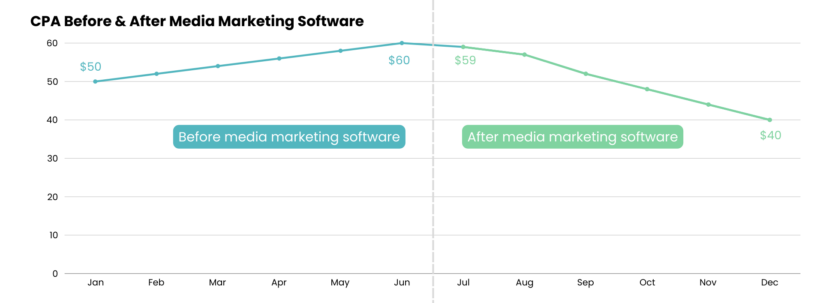
Consider proactively marketing to these users to remind them that the subscription renewal period is approaching, and offering subsequent discounts or incentives to renew their subscriptions. You can achieve this through email campaigns, in-app reminders, and even push notifications.
Tracking the success of these campaigns through the marketing platform is critical to your ability to iterate the strategy month by month. That way, you’ll know you’re taking the best approach with every future customer whose subscription renewal period is approaching.
6. Cost Per Acquisition (CPA)
A final important metric is how much of your marketing budget you’re spending to bring in new customers. A media marketing solution may not be able to help you directly understand this metric, but all the things it does to advance your overall marketing strategy can still make a positive difference.
Create a baseline cost of what you spent on marketing campaigns prior to switching to a media marketing platform that could automate your user outreach, improve your user metrics, and track everything in one place. Divide that by the total number of new customers you obtained, and you have your Cost Per Acquisition (CPA) prior to using this software.
Once you have that metric, you can compare it to the CPA after implementing the software and your media marketing strategy, to determine how effective they have been in reducing your marketing spend, and how much you’ve saved in resources and time by automating the entire process.
| See how 18Birdies reduced its costs by 50% and managed to create a more cohesive experience for its customers using efficient automation capabilities of MoEngage such as in-app notifications. |
Provide the Best Media App Experience for Your Customers with MoEngage
Media and entertainment companies are constantly vying for audience attention, attempting to attract as many views, listens, reads, and interactions as they can with their content. But this also means curating experiences that drive subscriptions and keep customers coming back.
Media marketing solutions like MoEngage help entertainment companies deliver seamless user experiences that customers enjoy. They empower teams to create meaningful relationships with their customers that drive engagement and subscriptions.
Schedule a demo today to learn how MoEngage can power your media and entertainment marketing strategy, program, and individual campaigns.















